Back in 2012, I visited the Chelsea Flower Show for the first time. It was all wonderful but the garden which really touched me was The Brontë Garden, created by Tracy Foster for the tourist agency, Welcome to Yorkshire. Not only did it win a gold medal, it also, deservedly, won the People’s Choice for the best Small Garden.
So I thought that a touch of countryside beauty – with a literary association – might be cheering.
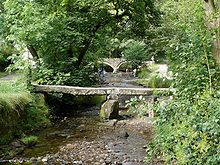
Bridges over Wycoller Beck
Tracy Foster aimed to ‘give a sense of the beauty and bleakness that epitomizes the wonderful moorland landscape,’ and succeeded beautifully. The word ‘garden’ is, perhaps, a misnomer. It is more an imaginative re-creation of the Yorkshire moors behind Haworth near Top Withens, the place said to have inspired Emily Brontë’s Wuthering Heights.
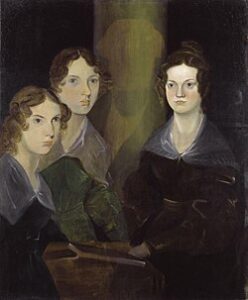
Anne, Emily and Charlotte Brontë by Bramwell Brontë courtesy of the National Portrait Gallery
But it has another literary association, too; nearby is Wycoller Dene, that is, the village of Wycoller and the wooded valley in which it sits. When I first visited Wycoller, it was almost deserted and semi-ruinous, and getting there was an extremely bumpy, not to say, hazardous drive. Wycoller Hall, which was pretty ruinous, too, was surrounded by fallen stones. It was supposed to have been Charlotte Brontë’s inspiration for the manor of Ferndean where Jane Eyre finally found Rochester, injured and blinded by the Thornfield fire which his mad wife had started, and which had gutted the house and killed her. Jane stayed to look after Rochester and, of course, as Jane herself tells us: Reader, I married him.

Wycoller Hall interior with huge fireplace; note curious keyhole-shaped cubby hole. What is it for?
The Brontë sisters all loved walking over the moors behind the Parsonage at Haworth. There is a five mile footpath which leads directly to Wycoller from Haworth – not far for keen walkers. The path crosses and re-crosses a number of bridges, as well as a ford and stepping stones over the meandering Wycoller Beck.
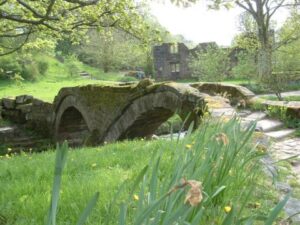
Bridge over Wycoller Beck with Wycoller Hall in the background
At the Chelsea Flower Show, The Brontë Garden took care to echo the Yorkshire landscape, and visitors saw an old clapper bridge crossing a moorland beck, behind which grew alder and silver birch. You could just glimpse a mullioned window through the trees and the tangle of moorland grasses – perhaps from the manor of Ferndean itself. The predominant colour was green but a few wild flowers peeped through: bluebells, ragged robin and primroses, with occasional clumps of ling and bell heather.
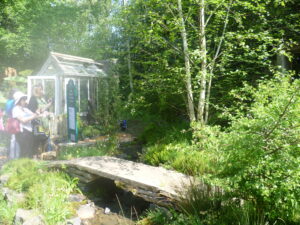
Chelsea Brontë Garden clapper bridge over a beck. Note the Chelsea visitors taking photos
Mrs Gaskell’s Life of Charlotte Brontë mentions Charlotte ‘visiting old halls and ruins’ when she was staying with the Kay-Shuttleworths at nearby Gawthorpe Hall. And there are local traditions in Wycoller dating back to the 19th century which suggest that Charlotte knew Wycoller well, and that she had based the manor of Ferndean in Jane Eyre on the ruinous Wycoller Hall.
The Brontë Garden was a faithful representation of how the Yorkshire moors scenery once looked – which still largely holds true today. The boulders in the beck were of local stone as was the dry stone wall surrounding the garden and the flat stone of the clapper bridge. They were left as found, covered with moss and lichen. It was all wonderfully atmospheric.
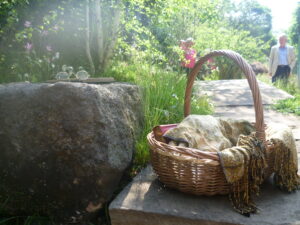
Chelsea Brontë Garden bridge with basket.
A pair of spectacles on an open book lay on a rock. Near it, at one end of the clapper bridge, sat a small willow basket, its contents covered by a fringed shawl. We feel that Emily cannot be far away and will return at any moment.

Adventurous teenagers
When I first visited Wycoller, visitors were free to roam about and climb the ruins as these two adventurous teenagers seem to have done

Picturesque clam bridge over Wycoller Beck.
Wycoller has now been turned into Wycoller Village and Country Park – all cars are forbidden, and there are discreet car parks, loos, ice creams and so on. And you certainly can’t climb on the buildings. They have done their best to keep its half creepy, half magical, atmosphere. I know you can’t have it both ways, but I cannot help preferring it when it was an adventure just getting there and it wasn’t tidied up.
All the same, Wycoller Village and Country Park has saved it from utter ruin, and for that I am grateful. And it reminds me how evocative landscape can be and how much natural beauty can inspire us as it inspired Charlotte, Emily and Anne. And how much we need it just now.
Elizabeth Hawksley
https://www.kobo.com/gb/en/ebook/frost-fair
https://www.smashwords.com/books/view/1056557
(Frost Fair)
Please share this page...
There is a kind of understated and subtle beauty to the English and indeed European landscape more generally which I think is underappreciated. I’m glad to hear that a garden such as this has gained some recognition.
Perhaps the key-shaped alcove is for keeping the fire irons?
Could be! But it is, perhaps, a touch large. I would suggest it’s a better place for storing wood. It is near enough to the fire to let damp or wet wood dry out, but the stone alcove is also safe from sparks.